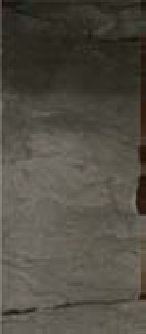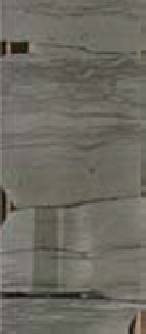Geoscience Reference
In-Depth Information
the observed bioturbation and deposition probably
took place in lagoons and bays. The sandstone beds
seem to record rather abrupt events of deposition
and are thought to represent crevasse splays spilled
from adjacent channels. A similar interpretation is
also favoured for the lower part of the cored section
in well 7124/3-1 (Fig. 8), which is related to depo-
sition in the overbank and smaller distributary
channels of the delta plain during the final phase of
terrestrial deposition in the Snadd Formation.
Based on its large thickness (app. 25 m), pri-
mary sedimentary features and the ribbon-like
geometry (Fig. 7), the main sandstone body in
Fig. 5 is thought to represent a major distributary
channel on the lower delta plain, with the basal
conglomerate forming an eroded lag deposit.
Some tidal influence may be inferred from the
observed paired drapes on the cross-stratified sets
and it is assumed that the channel filled due to
dune migration under the influence of both fluvial
and tidal currents. The massive sandstone beds
may record rapid fall-out of suspended sandy sed-
iment during waning flows (e.g. Johnson, 1984).
All the ribbon-like features seen in the seismic
data (Fig. 7) may represent channelised sandstone
bodies isolated within the fine-grained delta plain
deposits. The large variation in orientation and sin-
uosity between individual channels may relate to a
very low depositional gradient typical for lower
delta plain settings (e.g. Reading & Collinson, 1996).
Similar seismic features are observed in several 3D
seismic surveys throughout the Snadd Formation.
Sandstone thicknesses are highly variable and
occasionally exceeding 50 m, with widths reaching
maximum values of up to 20 km (Henriksen
et al
.,
2011). Such data clearly show that some significant
channel systems were present, possibly funnelling
large amounts of sediment through the Late Triassic
delta plain of the Barents shelf.
Wave-rippled and bioturbated strata in the
uppermost part of the Snadd Formation (Fig. 8)
are related to marine reworking of the underlying
delta plain during the final transgression/marine
incursion of the delta plain. These strata are in
turn succeeded by mudrocks in the Fruholmen
Formation.
(A)
(B)
(C)
806.4 m
802.4 m
801.8 m
(D)
(E)
(F)
798.4 m
785.8 m
782.5 m
Fig. 6.
Core photographs, Snadd Formation, well 7222/11-1.
(A) Bioturbated/rooted siltstone capped by thin coal bed; (B)
Moderately bioturbated sandy mudrock with wave-ripple
lamination; (C) Thin-bedded sandstone beds in weakly bio-
turbated background sediment; (D) Sharply based intraclast
conglomerate/channel base lag deposit; (E) Medium-grained
sandstone with dm-scale cross-stratification; (F) Cross-
stratified sandstone with paired (?), muddy/micaceous
drapes on fore-sets. Core width is ~12 cm.
and other pedogenic features, as was also seen in
well 7222/11-1 (Fig. 5). The overlying association
is approximately 12 m thick and composed of very
fine-grained to fine-grained, micaceous sandstone,
dominated by wave-generated primary structures
and some intensively bioturbated intervals.
As shown in Fig. 5 (well 7222/11-1), the hetero-
lithic deposits below the main sandstone body are
related to deposition in a lower delta plain envi-
ronment. The coal beds and root horizons reflect
soil formation and accumulation of organic mate-
rial. Some marine influence can be inferred from
Norian to Rhaetian delta progradation
(Fruholmen Formation)
Above the Snadd Formation, the basal mudrocks
of the Fruholmen Formation in well 7124/3-1
(Fig. 8) are dark grey and laminated, with abundant






Search WWH ::

Custom Search